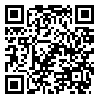1. [1] میرزایی، محترم، و فیروز آبادی، سید محمد، "کاربرد داده¬کاوی در پیش¬بینی بقای پیوند کلیه و شناسایی متغیر¬های تاثیر¬گذار در بقای کلیة پیوندی"، مجله انفورماتیک سلامت و زیست پزشکی، مرکز تحقیقات انفورماتیک پزشکی، دوره 3، شماره 1، صفحات 1-9، 1395.
2. [1] M. Mirzaei, and M. Firooz Abadi, "The impact of data mining on prediction of renal transplantation survival and identifying the effective factors on the transplanted kidney," Journal Of Health and Biomedical Informatics, Medical Informatics Re-search Center, vol. 3, pp. 1-9, 2016.
3. [2] جوانروح گیوی، نیلوفر، علیمی، رسول، اسماعیلی، حبیب ا...، شاکری، محمد¬تقی، و شمسا، علی، "عوامل مؤثر بر بقای پیوند کلیه و برآورد خطر رد پیوند برای پیوند شدگان مراجعه کننده به بیمارستان قائم مشهد"، مجله دانشگاه علوم پزشکی خراسان شمالی، دوره 5، شماره 2، صفحات 315-321، 1392.
4. [2] N. Javanroh Givi, R. Alimi, H. Esmaily, M. T. Shakeri, and A. Shamsa, "Assessment of effective factors on renal transplantation estimation of rejection hazard for transplanted in Mashhad Qaem hospital," Journal of North Khorasan University of Medical Sciences, vol. 5, pp. 315-321, 2013. [
DOI:10.29252/jnkums.5.2.315]
5. [3] اشرفی، مهدی، و همکاران،" پیش¬بینی بقای پنج ساله پیوند کلیه با استفاده از مدل شبکة عصبی مصنوعی: گزارش 22 سال پی¬گیری از 316 بیمار در اصفهان"، مجله دانشکده پزشکی، دانشگاه علوم پزشکی تهران، دوره 67، شماره 5، صفحات 353-359، 1388.
6. [3] M. Ashrafi, and et. al, "Application of artificial neural network to predict graft survival after kidney transplantation: reports of 22 years follow up of 316 patients in Isfahan," Tehran University Medical Journal, vol. 67, pp. 353-359, 2009.
7. [4] الماسی حشیانی، امیر، رجایی¬فرد، عبدالرضا، حسن¬زاده، جعفر، وصلاحی، حشمت¬ا...،" تحلیل بقا پیوند کلیه و ارتباط آن با سن و جنس دهنده و گیرنده عضو بین بیماران پیوند شده"، مجله علمی دانشگاه علوم پزشکی سمنان، جلد 11، شماره 4، صفحات 302-307، 1389.
8. [4] A. Almasi Hashiani, A. Rajaeefard, J . Hassanzade, and H. Salahi, "Survival analysis of renal transplantation and its relationship with age and sex," Koomesh, vol. 11, pp. 302-307, 2010.
9. [5] T. D. Noia, and et al, "An end stage kidney disease predic-tor based on an artificial neural networks ensemble," Expert Systems with App-lications, vol. 40, pp. 4438-4445, 2013. [
DOI:10.1016/j.eswa.2013.01.046]
10. [6] G. Santori, I. Fontana, and U. Valente, "Applica-tion of an artificial neural network model to predict delayed decrease of serum creatinine in pediatric patients after kidney transplantation," Transplant Proc, vol. 39, pp. 1813-1819, 2007. [
DOI:10.1016/j.transproceed.2007.05.026] [
PMID]
11. [7] T. S. Brown, and et al, "Bayesian modeling of pre transplant variables accurately predicts kidney graft survival," Am J Nephrol, vol. 6, pp. 561-569, 2012. [
DOI:10.1159/000345552] [
PMID]
12. [8] J. Lasserre, S. Arnold, M. Vingron, P. Reinke, and C. P. Hinrichs, "Predicting the outcome of renal transplantation," J Am Med Inform Assoc, vol. 19, pp. 255-262, 2012. [
DOI:10.1136/amiajnl-2010-000004] [
PMID] [
PMCID]
13. [9] A. H. Hashemian, B. beiranvand, M. Rezaei, A. Bardideh, and E. Zand-Karimi, "Comparison of artificial neural network of kidney transplant survival," International Journal of Advanced Bio-logical and biomedical Research, vol. 1, pp. 1204-1212, 2013.
14. [10] R. J. Oskouei and B. S. Bigham, "Over-sampling via under-sampling in strongly Imbalanced data," International Journal of Advanced Intelli-gence Paradigms, 2015.
15. [11] M. M. Rahman, and D. N Davis, "Addressing the class imbalance problem in medical datasets," Int J Machine Learning and Compute, vol. 2, pp. 224-228, 2013. [
DOI:10.7763/IJMLC.2013.V3.307]
16. [12] N. V Chawla, "Data mining for imbalanced datasets: an overview," Data Mining Knowledge Discovery Handbook, 2005.
17. [13] Y. Sun, A. K. C. Wong, and M. S Kamel, "Classification of imbalanced data: a review," Int j patt Recogn Artif Intell, vol. 4, pp. 687-719, 2009. [
DOI:10.1142/S0218001409007326]
18. [14] D. C. Li, C. W. Liu, and S. C. Hu, "A learning method for the class imbalance problem with medical datasets," J comput Bio Medi, vol. 5, pp. 509-518, 2010. [
DOI:10.1016/j.compbiomed.2010.03.005] [
PMID]
19. [15] حسین¬خانی، فاطمه و ناصر¬شریف، بابک،" دو روش تبدیل ویژگی مبتنی بر الگوریتم¬های ژنتیک برای کاهش خطای دسته¬بندی ماشین بردار پشتیبان"، مجله پردازش علائم و داده¬ها، جلد 24، شماره 2، صفحات 23-39، 1394.
20. [15] F. Hoseinkhani, and B. Naser Sharif, " Two methods of converting feature based on genetic algorithms to reduce the classification error of support vector machine," Journal Of signs and data Processing, vol. 24, pp. 23-39, 2015.
21. [16] H. Hoglund, " Tax payment default prediction using genetic algorithm-based variable sele-ction," Expert Syst Appl, vol. 88, pp. 368-375, 2017. [
DOI:10.1016/j.eswa.2017.07.027]
22. [17] S. Nagpal, S. Arora, S. Dey and Shreya, " Feature selection using gravitational search algorithm for biomedical data," Procedia Comput Sci, vol. 115, pp. 258-265, 2017. [
DOI:10.1016/j.procs.2017.09.133]
23. [18] X. We and et. al, "Top 10 algorithms in data mining," knowl Inf Syst, vol. 14, pp. 1-37, 2008. [
DOI:10.1007/s10115-007-0114-2]
24. [19] J. H. Holland, " Adaptation in natural and artifi-cial systems," University of Michigan Press, 1975.
25. [20] D. E. Goldberg, "Genetic algorithms in search optimization and mechine learning," Addison-Wesley Publishing, INC. Reading. Mass, 1989.
26. [21] S. Olariu and A. Y. Zomaya, "Handbook of bioinspired algorithms and applications," Taylor & Francis Group, LLC Press, 2006. [
DOI:10.1201/9781420035063]







